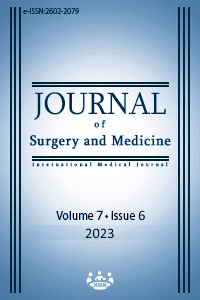Elective cesarean section versus induced vaginal delivery: Do any differences in terms of neonatal respiratory morbidities exist?
Elective cesarean section versus induced vaginal delivery
Keywords:
transient tachypnea of the newborn, induced vaginal delivery, elective cesarean section, fetal complicationsAbstract
Background/Aim: Transient tachypnea of the newborn (TTN) is mostly a benign and self-limiting common physiological disorder. Certain factors, such as elective cesarean section (CS) not preceded by spontaneous labor, delivery before 39 gestational weeks, and perinatal asphyxia, interfere with the fetal–neonatal transition. In our study, we aimed to review the results of hospitalized newborns who receive a diagnosis of TTN and investigate the possible relationship between the implementation of labor induction and the occurrence of this disorder.
Methods: This study used a case-control study design. We scanned the hospital records of 156 term newborns hospitalized between January 2017 and January 2018 who received a diagnosis of TTN and who did not have any additional fetal and/or maternal risk factors. Demographic features, mode of delivery, and implementation of labor induction in vaginal deliveries were recorded and compared to the data from 150 healthy term infants. Infants were then split into two groups according to their type of labor induction, and a separate subgroup analysis was performed in terms of the risk of TTN development.
Results: The incidence of TTN was 2.9% in vaginal deliveries and 8.5% in CSs. Differences between groups regarding gestational age, birth weights, gender, elective induction in vaginal deliveries, interventions in the delivery room, and types of intervention were found (P<0.05). The risk of developing TTN was 2.5 times higher in the induction group compared to those who did not receive induction but still developed TTN (P<0.001). Also, the risk was significantly higher in the induction group compared to those who did not receive induction and did not develop TTN (P<0.001). After applying a logistic regression analysis, labor induction (odds ratio: 1.005; 95% confidence interval: 1.003–1.008, P<0.001) was found to be an independent significant risk factor for developing TTN.
Conclusions: This study indicates that infants born via electively induced vaginal delivery had significantly higher rates of TTN. Therefore, elective labor induction can be added as a new risk factor for TTN development. In our opinion, labor induction without valid medical and obstetric indications should be avoided due to maternal and fetal complications.
Downloads
References
Guglani L, Lakshminrusimha S, Ryan RM. Transient Tachypnea of the Newborn. Pediatr Rev. 2008;29:e59–65. DOI: https://doi.org/10.1542/pir.29.11.e59
McCray PB, Bettencourt JD, Bastacky J. Developing bronchopulmonary epithelium of the human fetus secretes fluid. American Journal of Physiology-Lung Cellular and Molecular Physiology. 1992;262:L270–9. DOI: https://doi.org/10.1152/ajplung.1992.262.3.L270
Matalon S, Bartoszewski R, Collawn JF. Role of epithelial sodium channels in the regulation of lung fluid homeostasis. American Journal of Physiology-Lung Cellular and Molecular Physiology. 2015;309:L1229–38. DOI: https://doi.org/10.1152/ajplung.00319.2015
Jain L, Eaton DC. Physiology of Fetal Lung Fluid Clearance and the Effect of Labor. Semin Perinatol. 2006;30:34–43. DOI: https://doi.org/10.1053/j.semperi.2006.01.006
Gomella T.L. EFG, Bany-Mohammed F. Transient Tachypnea of Newborn. In: Gomella TL. In: Gomella’s Neonatology. 2020. p. 1107–14.
Boyle A, Reddy UM, Landy HJ, Huang C-C, Driggers RW, Laughon SK. Primary Cesarean Delivery in the United States. Obstetrics & Gynecology. 2013;122:33–40. DOI: https://doi.org/10.1097/AOG.0b013e3182952242
Hermansen CL, Lorah KN. Respiratory distress in the newborn. Am Fam Physician. 2007;76:987–94.
Landon MB, Hauth JC, Leveno KJ, Spong CY, Leindecker S, Varner MW, et al. Maternal and Perinatal Outcomes Associated with a Trial of Labor after Prior Cesarean Delivery. New England Journal of Medicine. 2004;351:2581–9. DOI: https://doi.org/10.1056/NEJMoa040405
Joseph K, Bhargavi B, Jain CS, Reddy DR. Impact of cesarean section on transient tachypnea of the newborn: a longitudinal study. Int J Contemp Pediatrics. 2021;8:467. DOI: https://doi.org/10.18203/2349-3291.ijcp20210505
Hagen E, Chu A, Lew C, Pulmonology ‡. Transient Tachypnea of the Newborn Education Gaps. http://neoreviews.aappublications.org/.
Kasap B, Duman N, Özer E, Tatli M, Kumral A, Özkan H. Transient tachypnea of the newborn: Predictive factor for prolonged tachypnea. Pediatrics International. 2008;50:81–4. DOI: https://doi.org/10.1111/j.1442-200X.2007.02535.x
Khasawneh W, Obeidat N, Yusef D, Alsulaiman JW. The impact of cesarean section on neonatal outcomes at a university-based tertiary hospital in Jordan. BMC Pregnancy Childbirth. 2020;20:335. DOI: https://doi.org/10.1186/s12884-020-03027-2
Thomas J, Olukade TO, Naz A, Salama H, Al-Qubaisi M, Al Rifai H, et al. The neonatal respiratory morbidity associated with early term caesarean section – an emerging pandemic. J Perinat Med. 2021;49:767–72. DOI: https://doi.org/10.1515/jpm-2020-0402
Kirkeby Hansen A, Wisborg K, Uldbjerg N, Brink Henriksen T. Elective caesarean section and respiratory morbidity in the term and near-term neonate. Acta Obstet Gynecol Scand. 2007;86:389–94. DOI: https://doi.org/10.1080/00016340601159256
Al Bizri A, Boghossian NS, Nassar A, Nakad P, Jaber D, Chahine R, et al. Timing of term elective cesarean section and adverse neonatal outcomes: A multi-center retrospective cohort study. PLoS One. 2021;16:e0249557. DOI: https://doi.org/10.1371/journal.pone.0249557
Raju TNK, Higgins RD, Stark AR, Leveno KJ. Optimizing Care and Outcome for Late-Preterm (Near-Term) Infants: A Summary of the Workshop Sponsored by the National Institute of Child Health and Human Development. Pediatrics. 2006;118:1207–14. DOI: https://doi.org/10.1542/peds.2006-0018
Ramsey PS, Ramin KD, Ramin SM. Labor induction. Curr Opin Obstet Gynecol. 2000;12:463–73. DOI: https://doi.org/10.1097/00001703-200012000-00002
Einerson BrettD, Grobman WA. Elective induction of labor: friend or foe? Semin Perinatol. 2020;44:151214. DOI: https://doi.org/10.1016/j.semperi.2019.151214
Kondrad E, Liegl S. Labor Induction at Term. Am Fam Physician. 2016;93:266–8.
Moore LE, Rayburn WF. Elective Induction of Labor. Clin Obstet Gynecol. 2006;49:698–704. DOI: https://doi.org/10.1097/00003081-200609000-00026
Little SE. Elective Induction of Labor. Obstet Gynecol Clin North Am. 2017;44:601–14. DOI: https://doi.org/10.1016/j.ogc.2017.08.005
Baud D, Rouiller S, Hohlfeld P, Tolsa J-F, Vial Y. Adverse obstetrical and neonatal outcomes in elective and medically indicated inductions of labor at term. The Journal of Maternal-Fetal & Neonatal Medicine. 2013;26:1595–601. DOI: https://doi.org/10.3109/14767058.2013.795533
Jegard C, Korb D, Rideau A, Sibony O. Impact of precipitous labor on the onset of transient tachypnea in vaginal deliveries at term. International Journal of Gynecology & Obstetrics. 2022;158:643–9. DOI: https://doi.org/10.1002/ijgo.14060
Downloads
- 1154 772
Published
Issue
Section
How to Cite
License
Copyright (c) 2023 Mahli Batuhan Özdoğar, Murat Ayar, Şerif Hamitoğlu, Özgür Olukman
This work is licensed under a Creative Commons Attribution-NonCommercial-NoDerivatives 4.0 International License.
















